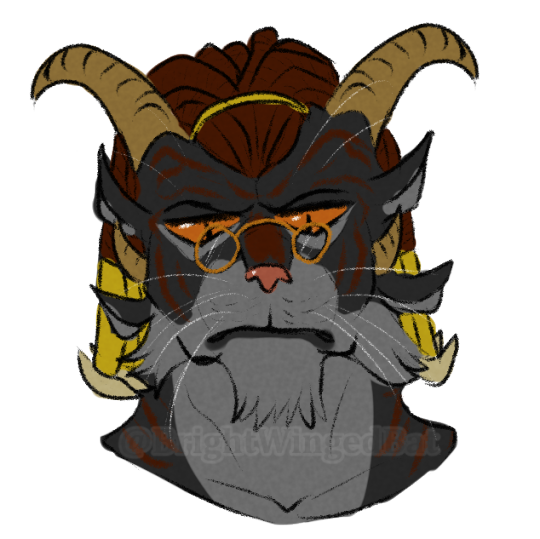Hey I blog about mostly gaming stuff. Currently focused on Guild Wars 2, add me if you want: Mountainmoose.8095 (icon by @astralarias)
Don't wanna be here? Send us removal request.
Text

Pay-What-You-Want-Commission for @brightwingedbat. His blind flame legion shaman, Magus ♥
--- Commission Info https://ko-fi.com/nektariusrex/commissions
85 notes
·
View notes
Note
11 and 14, RytLeo 👁️👁️
14. What's an opinion they'll never agree on? How do they deal with that?
Theyll never agree on what happened in the mists, and Leo will never forgive him for freeing Balthazar lmao.
The thing you must know was that in ls2 Leo was trying So Hard to convince Rytlock to let him do the ritual. He has a strong magical background, has a deel understanding of the spectral magic in Ascalon, ane is, as a necromancer, extremely familiar with the mists. In Leo's eyes it SHOULD have been him, so when things started going off the walls Leo was nearly the one to go in but was blindsided by the imperator stopping him bc it was Rytlock's duty specifically, and Rytlock urgently chasing after it.
Leo, you have to remember, his whole THING IS trying to free to souls of Ascalon, thats literally what his huge reason for becoming a necromancer was. So he felt robbed by the charr chain of command. THEN learning that Rytlock freed Balthazar? It didnt matter sohothin was back in posession at that point, even so Leo KNEW the mask Rytlock puts on, he Knows Rytlock's dependency on sohothin due to his past of being bullied and treated as less than. Yes, Rytlock was manipulated by a human god, but its Because Leo already has this idea in his head that it Should Have Been Him, that he is being 10x harsher. He, in his mind, wouldnt have fallen for it, he would have known better, he would have found another way. And he is Hypocritical, bc Leo made a pact with a human god (grenth). Its just the consequences of that pact are only on him, Rytlock brings this up during an argument but it doesnt phase leo bc the only person losing bc of that deal Is Him, no one else got hurt.
Do I think Leo was correct for being angry? Yeah, but I also think hes extremely stubborn, self-righteous, and hypocritical. There isnt meant to ever be a good resolution for this, its forever a huge chasm in their relationship and goes back to how I frame their relationship as the ashes of a fire post pof.
Its even worse that the commander was killed then had to defy death (something leo hates bc he holds the cycle of life and death as sacred) which adds to him already being pissed LMAO.
11 is here!
9 notes
·
View notes
Text

June has come around again, which means I've been posting to this blog for nearly a year, and it's Pride 2025! Best wishes and all the support for everyone here from me and my silly cast of characters!
From left to right, the characters and their pronouns are: Sorcha - she/they Pyrite - he/him Adelaide - she/her Caloghira - she/her
(someday i may draw my whole roster (all 25+ of them) for Pride but these four should be recognizable!)
137 notes
·
View notes
Note
Moose-man, what have thou been up to???
Short answer is I've been taking a break from guild wars. Is getting to exam season and I've been playing other games with the limited time I have. Been playing the cyberpunk 2077 DLC recently and things are going.... very very poorly. I almost got hit by a spaceship!

1 note
·
View note
Text





The only way I can draw my charr in under a day is through meme redraws, apparently!
In order, Sigmund Brighthorn, Dusty Wanderhorn, Cassius Witherpaw, Artorias Swordarm, and Umbriel Starcaller
54 notes
·
View notes
Text
The Mist War (headcanons essay 4/4) Beasts and Denizens of the Mists
The Mist War is both an event and a place at the same time, one that in theory works like a massive Fractal, but in practice varies in particular ways due to its multiverse nature and much bigger scale. [back to masterpost]
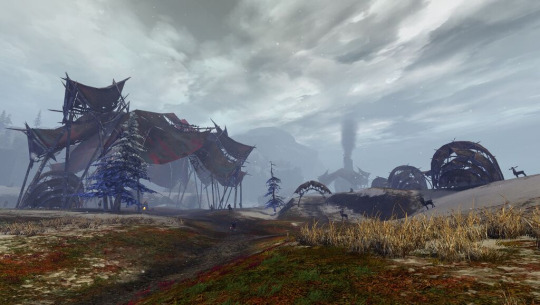
Who else dwells in the Mists?
Other than the Mist Warriors, there are other living beings who call the battlegrounds and the neutral lands their home.
The animals present in the lands seem to be part of the Mists themselves in some way, as they return to their lives everyday despite being slain at a frequency no MW would survive. Notably, the supplies gathered from them persist long after their remains disappear and the animals are revived at what seem to be smaller nexus attuned to them. This is unlike what happens with supplies harvested from animals brought in from Tyria, who fully disappear not long after dying and eventually stop being resurrected by the magic surges. Due to this, there are strict limitations on bringing external animals into the Mists, lest they accidentally give the MW a bad surprise when they're needed. These animals reproduce more sparingly than their Tyrian counterparts, possibly as there's no need to constantly replenish their numbers, given that the only known way for them to permanently die seems to be old age. Another possibility is that being slain so frequently keeps them from bearing offspring, which might be why most animals stick to living in neutral lands and newer generations are rarely spotted outside of areas hard to reach. Notably, it is possible to take these animals out of the Mists, but they will lose their attunement and become just like any other Tyrian creature when brought back into the Mist War.
One particular case is the massive dolyak population endemic within the lands, who are tame and don't seem to particularly mind being used by the MW as supply carriers or food. Curiously, they all seem to be the same herds that persist across resets, as they remember the MW who handled them, have preferences, and even respond to given names and commands they previously learned. Whether they're the same herds across different Tyrias is still uncertain, as data on the matter is conflicting.
Scattered across the lands there are various communities of other Tyrian races (skritt, centaur, hylek, krait, dredge, harpies, ogres, etc) that made the Mists their home over the centuries. While they're not yet one with the Mists, if that's even an actually possible outcome, they have fully embraced their existence within them, peacefully sharing living spaces with their kind from other Tyrias, regardless of the hardships of communication and their own past bloody quarrels. Mist degradation still affects them, but those communities minimize the risks by living as much of a peaceful life they can, though a few conflicts between their races have not stopped in centuries (harpies invading ogres' territory, hylek regularly defending themselves from krait, dredge having to deal with the same destroyers that chased them into the Mists, etc). While they consider themselves not part of the Mist War itself and always keep a degree of passivity in it, at times individuals or entire communities decide to join their world's fight as mercenaries or guards, usually in exchange of aid with their own issues, supplies, or after some "convincing" on the part of the MW. Their allegiances are mutable however, as they no longer see the need of a constant war for resources and ultimately just want to be left out of it as much as possible. It's unclear what happens to aging individuals, as degradation seems to claim most of them before sickness or natural death come for them. Though not firsthand, there have been reports of elders leaving their community and adventuring into neutral lands, never returning even after multiple surges and resets.
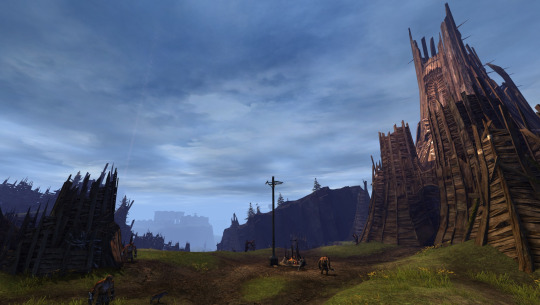
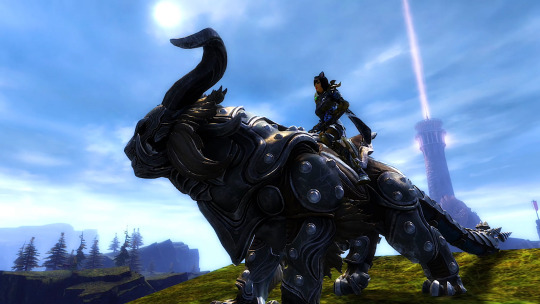
Warclaws
Warclaws were initially discovered during Durmand Priory expeditions into the Mist War, when they manifested after parts of armor found scattered in the battlegrounds were reassembled. Since then, many more warclaw armor pieces have been found in the battlegrounds, as if the first "armored-soul" revealed their presence. At first they were thought as mindless constructs, but over time their animal-like behavior confirmed they were spirits bound to armors of mixmatched Tyrian design, but any details of the ancient Mist War that created them were lost to time.
The discovery of the armored-souls also seemingly started attracting a variety of different beasts never seen before to the neutral lands. Appearing after a few resets and slowly increasing in number over more, all these new beasts behaved similarly to the armored-soul warclaws, and while they lived their lives as regular animals, they also appeared to willingly search MW to bond with, usually after challenging them to fights. Despite their differences, all the beasts were given the same umbrella name of warclaws, as after taming and studying enough of them, it was clear that they all showcased the same range of abilities, ones that lessened equally for all once taken out of the Mists and into Tyria. Notably, some warclaws appear to take on the form of other Tyrian creatures and spirits (usually more or less feline in nature), but nothing else about them seems to match their counterparts. As such, warclaws being creatures of the Mists that simply mimic Tyrian creatures has been the working theory for decades, but everything else about their origin is still unknown. Up until the last few years it was feared that being in Tyria and away from the Mists would be harmful to the warclaws in the long run, like it is for other creatures, so only a few were ever allowed to be extracted and taken in by the Priory for long-term studies. However, after it was clear that they all adapted perfectly with no signs of suffering and their attunement to the Mists was not ruined even after years, the all clear was given to the MW who wanted to bring their warclaws with them back to Tyria.
In the Mist War, the strength of the warclaws is often instrumental in taking down gates faster by pulling on them with chains, and they're terrifying foes in battle due to their size, pouncing on enemies and mauling them with scary efficiency. While they're capable of sudden bursts of speed on shorter distances, they're not built for speed or agility, instead being able to travel at a sustained speed for hours without breaks, allowing the MW to return to the battlefront faster than they could on foot. Warclaws are not only physically powerful beasts, but they're also inherently magical. While they can't cast spells, they naturally use the magic around them, as shown by their accelerated healing, their stamina that replenishes constantly, and the fact that their presence amongst MW on foot seems to boost their speed as well for a short time (mostly due to the MW's limits). They still need to eat meat, but at a much lower rate than what a regular beast their size would require, so it's possible that they also partially sustain themselves on ambient magic. Their abilities are limited outside of the Mists, but they're still deadly creatures in their own right.
All warclaws don't seem to be affected by Mist degradation in any capacity, which might be due to them being created within the Mists (a likely valid statement for the armored-souls), having potentially existed in them for centuries, or some yet unknown magic of their own. The latter seems to be the most valid theory, as when they die, their bodies disappear like the MW's, but instead of returning to the nexus, they'll reappear close to the MW they bonded with. Intelligent beyond their appearance and loyal to the point of not fearing death, if the MW they bonded with permanently dies, they'll either find someone else to bond with or leave. While they can't return to life if they die outside of the Mists, their accelerated magical healing remains quite strong and can bring them back from the brink of death.
The recent discovery of the journeykin species in the Lowland Kodans' territory threw scholars for a loop. Initially they seemed to be a whole new species "made of pure magic" as some locals described them, one that showcased abilities unseen before, but then the conclusion that the journeykins are another form of warclaws was reached pretty fast. Doubt was cast after finding out that their magical signatures matched, and then definitely confirmed after exposition of other warclaws to journeykins allowed the first to mimic the second's abilities, seemingly unlocking their hidden potential outside of the Mists. Likewise, bringing journeykins into the Mist War made them behave just like other warclaws. With this new discovery, all warclaws in Tyria soon learned to harness the magic in the environment like their Lowland cousins, allowing them to both run faster than ever and use the magic itself to jump in the air and soothe their falls. A lot more research on them still has to be made, but current theories oscillate between journeykins being just another "subspecies" of warclaw that adapted to life on Tyria, their spirits being the ones used to infuse the armors in ancient times, or them being the original form or even progenitor of all warclaws.
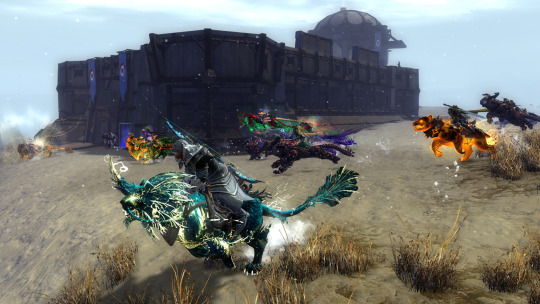
8 notes
·
View notes
Text
The Mist War (headcanons essay 3/4) Ranks and the Enemies
The Mist War is both an event and a place at the same time, one that in theory works like a massive Fractal, but in practice varies in particular ways due to its multiverse nature and much bigger scale. [back to masterpost]
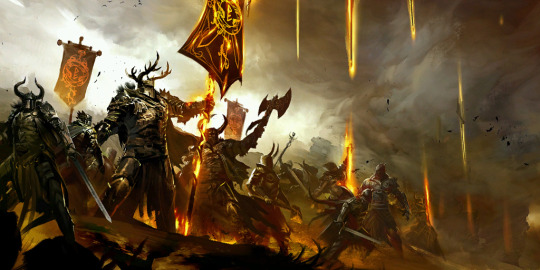
Ranks and roles
There is no formal structure to the "armies" in the Mist War, and the actions of every individual dictates its course. Each Tyria seems to have its own internal rules, but generally anyone can simply head out on their own or with a small team, with no need to ask permission or report about it. Just as freely, anyone willing to do so can gather a battalion of volunteers and command them to charge towards an enemy's objective or army, then step down at any point.
Comradery and putting the group first are at the core of this improvised system, and regardless of occasional hiccups and issues, things have run smoothly enough over the centuries to be considered reliably functional. It's mostly up to the MW themselves to decide who to trust in leading positions, and ranks are fluid to allow able soldiers to cover the necessary roles as new objectives are conquered and allies fall or return. Out of those left behind to take care of the captured objectives, the strongest and most reliable individuals at a given time are usually the ones put in charge with the title of supervisor or "lord", and they keep the place and supply chains running by assigning roles to everyone else and acting as the last line of defense. Arguments and drama about assignments and matters of merit are not uncommon, far from it actually, so ranks and roles can easily shift depending on what happens from day to day. Still, in the long run ineffective and self-serving individuals are usually pushed out of unsuitable roles for them, as most MW generally end up listening to those who prove reliable and knowledgeable. Understandably, many prefer to avoid meddling with others, and either consider themselves a solo act or stick to their smaller groups.
While all are generally called Mist Warriors, not everyone is in the battlegrounds for the Mist War specifically: people who just want to gather the specific resources they need and be done with it, those who are there exclusively for research, criminals or people who want to disappear by hiding in there, mercenaries who come to earn a quick coin through loot, those who join to test themselves, and the many who are simply merchants or other professionals who chose to lend their expertise. As such, the majority of Mist Warriors are groups and individuals who act on their own accord and scour the lands for their own interests, with bands forming and dissolving as common objectives are found and conquered. While in a regular army such scattered individual actions would be counterproductive, in the Mist War they're strongly encouraged, since it means having more eyes scouting the whole battleground and constant pressure on the enemy, as well as more chances of defending territory in danger or reconquering what has been lost. Still, the success rate is always higher with someone commanding and directing even a ragtag army, and especially so when fighting against enemies who are already organized. As such, small groups or guilds form and organize to lead bigger operations, gathering as many volunteers as they can, and at times enormous battles can break out anywhere two such armies meet. Banners are improvised, more of a way to distinguish groups of allies than to be recognized by the enemy, or a way to mark one group's achievements.
Be them roamers or part of larger groups, MW tend to travel light in supplies, only taking with them what's necessary and using whatever they can find or loot along the way. Those who leave the camps do so knowing that they could die at any moment, and while there's comfort in knowing they'd likely come back, all they had with them but not on them at the moment of death would be lost and potentially fall into enemy hands. Interestingly, when a MW takes loot from a fallen enemy before they disappear, those items will remain in that MW's possession even after the enemy's resurrection. This essentially duplicates items, as the same enemy will be revived with that was on them at the moment of death, regardless of whether they were looted or not. However, this phenomenon doesn't happen when taking items that were on fallen allies, as those items will always disappear with them and only return after a successful resurrection, implying that the Mists can duplicate items only when they originated from a different Tyria. As such, allies tend to gather important items and supplies left behind by their disappeared fallen, in order to either make use of them, not let them fall into enemy's hands, or return them after resurrection.

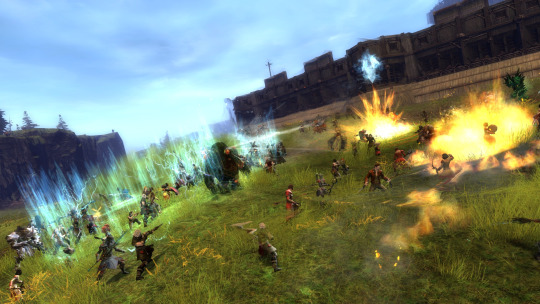
The enemy
The general idea shared by many MW is that the people from other Tyrias are inherently pure evil, and they hold onto it in spite of the solid proof of the contrary, shown in the Armistice Bastion's very existence and all the temporary truces amongst the lands.
While some consider such a definitive statement just an understandable way to rationalize violence against the enemy and the pain suffered during the never-ending war, it usually has a basis of truth in extremely cruel actions taken by enemies of the past, leading to the cautionary assumption that every single one of them could do as much or worse. In truth, no Tyria is fully innocent, and while the "etiquette of behavior" varies between worlds (some stick to more honorable tactics, while others prefer not to fight fair), every individual can do as they please, for better or worse. Regardless, individually evil or not, they're still the enemy, and the general rule remains "kill or be killed".
To make matters worse, there's no way to clearly communicate between Tyrias other than through writing, which is not something that can easily happen during battles. For whatever interference of the Mists, speech from enemies is either unintelligible or inaudible, and their appearance is at times not exactly clear, their features somewhat altered or distorted by misty essence. Body language offers a simple yet limited way to communicate, but it's one that can easily make enemies flinch and react negatively. Still, it's enough that over time certain spots have become neutral grounds for those looking for duels, or for occasional peaceful interactions to happen. Prisoners are never really taken during battles, given that there's no way to extract info from them and that they'd only drain precious resources. Furthermore, the presence of an enemy among MW makes them spies that could relay info if they were to die, so keeping anyone from getting too close is considered the best option.
On the rarest of occasions, when a magic surge alters the balance in a specific way, the Mists themselves enforce a sort of truce that prevents harm to everyone in the Mist War, and nothing can be done until enough subsequent magic surges correct it. While communication is still hard and a lot of MW tend to leave for the duration of the truce, strides in understanding each other have been made during such occasions, and during one of them the Armistice Bastion was founded in an abandoned fort sitting on top of a minor nexus in the neutral lands. At first exclusive to the few Tyrias who started it and kept meeting over following links, over the years a few fortunate alterations persisted and allowed for the specific kind of magic that created the truces to be harnessed and used to keep the area safe and more stable. The alterations eventually expanded to more Tyrias, and more MW began to visit it, though always strictly on invitation to keep troublemakers out. While it's not a highly popular place in the Mist War as many don't even know of it, plenty of MW do appreciate its existence and tensions within it have always remained low.
Disturbingly, some say they've seen people they know or themselves amongst enemy ranks, but chances to corroborate these sightings have been scarce even at the Bastion and results are conflicting. Even if multiples of the same person actually existed across different Tyrias, they might as well be living entirely different lives, so having two "copies" being involved in the Mist War at the same time for long enough to actually meet could be nearly impossible from a statistical standpoint.
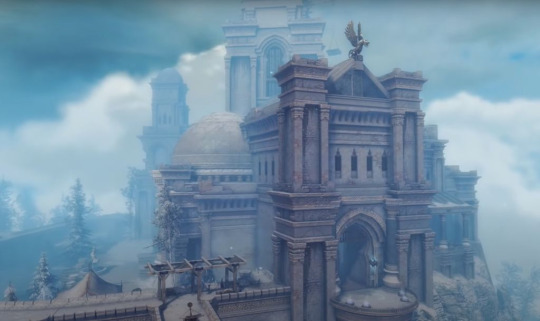
11 notes
·
View notes
Text
The Mist War (Headcanon essay 1/4) The Land in the Mists
The Mist War is both an event and a place at the same time, one that in theory works like a massive Fractal, but in practice varies in particular ways due to its multiverse nature and much bigger scale. [back to masterpost]
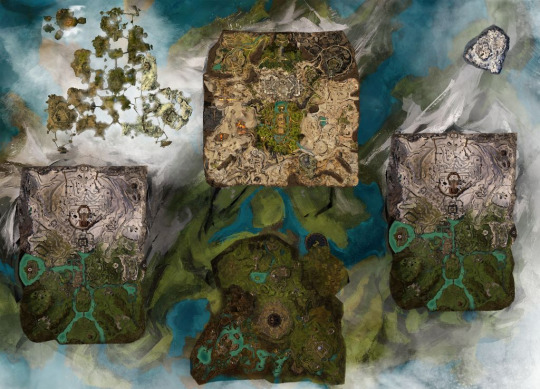
[Note: the map above is indicative of the limited instances of the Mist War witnessed by the cartographer, who hurried out of the Mists before completing it on site, making it likely inaccurate and/or outdated to present times]
Time and scale
For starters, time is on a different and more realistic scale compared to what we experience as players: ticks are not 5 minute intervals but individual hours, skirmishes don't last just 2 hours but a whole day (like the Tyrian in-game day-night cycles do), and resets can happen at any time between a few weeks and almost three months (there are 84 skirmishes between each reset).
The maps are also scaled more "realistically" as well, with the Alpine Borderlands being roughly around 100 x 50 km (62 x 31 miles), Desert Borderland matching the square area of them, and Eternal Battlegrounds being actually much larger than it appears compared to the others. While keeps, towers and camps are more or less proportionate between themselves, the same can't be said for the space between them, as the game always focuses on necessary details for points of interest and cuts out/reduces all that's not necessary or would be boring to traverse. Due to that, everything would be bigger and more complex than what we get to see: roads would go on for kilometers/miles, buildings would have the spaces needed to house and feed at least a handful of Mist Warriors passing through or defending the place, and the transition between environments would be softer and richer in features.
From the perspective of the Tyrians involved in it, the actual warfare is much slower than what we see, with a lot more downtime and preparations, as well as longer travel time between points on the map. The chaotic zerg fights are actually hours-to-weeks long battles and sieges. Rebuilding defenses after conquering an area takes hours at the fastest, instead of an instantaneous magical swirl after a few hammer hits. Getting from one's base to the enemy's garrison could take a few days of travel, especially with necessary rests and supplies to carry, and while warclaws are instrumental to moving faster across the land and can reach any destination in much less time than a Mist Warrior on foot, they're not built for speed and the journey would still take hours. But that would not be fun for us players, so we see/play the sped up version.
[To give a general idea with real life data, depending on the condition and terrain, the travel speed of an army goes between 8 and 30-something km/day, a regular person on foot can do 9-30 km/day, and a rider can reach 30-50 km/day with breaks to let the mount rest and eat. Warclaws are based on big felines, which can reach up to 80km/h on short distances while hunting, but due to their bigger size, armor and rider, they likely can't run that fast even when attacking, let alone maintaining that speed on longer distances. On top of that, even if Mist Warriors were stronger and faster than any person could be, after a long journey they'd still probably need to rest before actually joining the battle.]
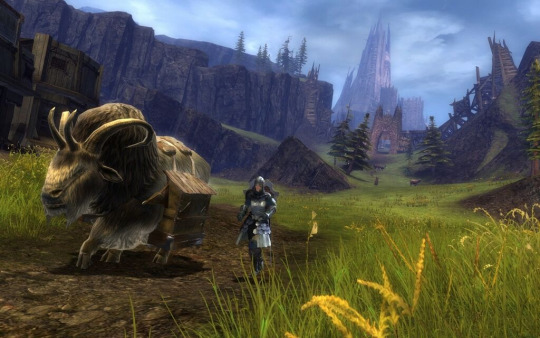
The Battlegrounds
The versions of Tyria (worlds or "servers") involved in the Mist War at a given time are not always the same ones, as they drift across and on top of each other through the Mists akin to tectonic plates, metaphysically clashing and causing incommensurable surges of magic that form the lands and fuel the phenomenon itself. There's no way to know how or why it all happened in the first place, but the extremely powerful magic at play there is enough to stabilize such a vast space for weeks and months at a time in its extended fractal-like state, almost immutable cycle after cycle, allowing for its resources to be extracted by each Tyria. Then, when the different versions of Tyria that the magic holds together drift apart and latch onto others (links), it all reverts to its original state (reset), repeating the process once more.
The area where the Mist War takes place is at the exact cross-section between three (sometimes more) different versions of Tyria, with the exact center being where the area known as the Eternal Battlegrounds is located. Each of the three Borderlands is, as their name implies, deeper into the "border" of one of those Tyrias. Most of the fighting happens there and in EV, where the harvestable resources are more easily accessible and plentiful. Neutral areas of scarce interest exist between those lands, but few have reasons to venture there, usually to reach the Obsidian Sanctum or the Armistice Bastion. The Edge of the Mists is a group of islands that floats above the lands, not as rich in resources but still valuable, and it was only recently reachable thanks to the invention of airships. Notably, the Borderlands used to be all similar, just with minor differences between them, but a fairly recent development caused the transformation (or substitution) of one of the normally alpine zones into a desert area, specifically the one located North of EB. Theories suggest that it might be a ripple effect of the first couple of deaths of the Elder Dragons, and the ancient structures in it may push forward the idea that the desert is not a new creation of the Mists, but that it simply re-emerged after a very long time, potentially for the first time since the last Dragonrise.
The never-ending cycle of conquest of those impermanent lands seems like a fool's errand, but the bountiful and ever-replenishing resources and research opportunities aid the warriors' own Tyria, so the war has been continuing with few interruptions for centuries, if not probably much longer. Conquering land not only is necessary to have access to more resources, but one Tyria having more influence over the others at the time of reset statistically seems to increase its following bounty of resources. Despite many attempts at peace having been made in the history recorded by Mist Warriors, greed and necessity won over reason again and again, usually long before the negotiating Tyrias were forcibly separated.
Across the whole land there are various points where the magic of different Tyrias is more powerful and functions as anchor points for each of them, usually following a specific pattern. Mist Warriors make their base of operations around the strongest nexuses, building their main camps in the pre-existing structures surrounding them and placing the asuran waypoints and gates nearby. Most of the other structures on the land are placed on or near smaller anchor points, some still operational and others so ancient they're but ruins. Before the creation of the asuran gates in Lion's Arch in 1324 AE, joining the Mist War required complex rituals known to few, or paying a hefty sum to reroute one of the existing asuran gates in Tyria. Moreover, one needed to be present for when the recruiters would come by, as they toured Tyria as much as possible to keep the numbers in the Mist War from ebbing on too few to be effective. The city of Lion's Arch eventually decided to more or less officially sponsor operations in the Mist War, and now the access is easy and eagerly encouraged by the Mist Warriors, who finally have the numbers to extract all the resources they need once they crush the other Tyrias... who have been doing the same exact thing.
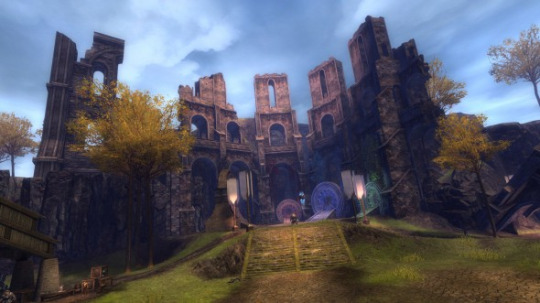
14 notes
·
View notes
Text
The Mist War (headcanons essay 2/4) Life and Death, dictated by the flow of the Mists
The Mist War is both an event and a place at the same time, one that in theory works like a massive Fractal, but in practice varies in particular ways due to its multiverse nature and much bigger scale. [back to masterpost]
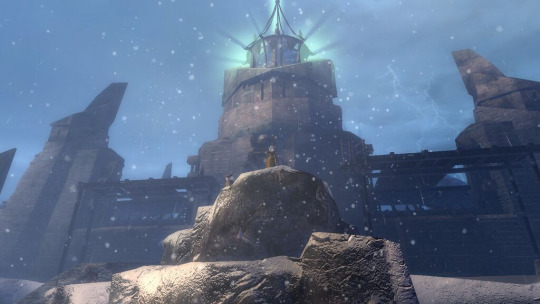
Magic surges and resets
The Mist Warriors still only have a vague idea of the complex rules of the Mist War. Despite learning all they could through centuries of observation and trial and error, there's too much they can never be certain of. The recent help of the Priory and the new knowledge related to the similar yet infinitesimally smaller Fractals helped a little, but the margin of error is still very large.
Magic surges are what dictates the cadence and flow of the events of the Mist War, affecting all that's in it. Caused by the metaphysical shift of the overlapping different Tyrias, they happen everyday around midnight (skirmishes) and, on a much larger scale, when the worlds drift apart and connect with others (reset).
The daily magic surges are the most predictable event in the Mist War, and while they're not really observable by the naked eye, they're describable as a wave of magic that curses through the fabric of the Mists, a pulse strong enough for those magically attuned to sense it even if if they're not near a nexus, and a brief reinvigorating sensation for everyone. Despite their regularity, sometimes they might shift in potency and cause temporary alterations to the normal conditions of the Mist War, be them positive (MW feeling more powerful, resources partially restoring themselves outside of resets, forced truces, supercharge of arcane tools, etc) or negative (MW feeling physically weaker or their abilities changing, malfunctions of tools and magic, higher frequency of displacements, thinner air or weather conditions that make gliding unsafe or impossible, more frequent anomalies, lack of animals and resources, skipped resurrections, etc), which usually last from a few days to a few weeks before returning to normal.
As for resets, there's no clear schedule for them, but various signs act as a warning days before it does: magical readings start fluctuating as the Mists begin to agitate, the sky gets increasingly brighter even at night, magic surges become increasingly more irregular, and the fog covering the horizon steadily increases and thickens. Then, when the reset is about to happen, all living beings will sense a disruption in the fabric of the Mists (a sensation of falling, like the ground shifting slightly), shortly followed by enemies beginning to fade intermittently for each other. Not long after that, the fog on the horizon will roll in and cover the borderlands, rising from a thin layer at ground level until nothing is visible in front of one's nose. Notably, MW will always see the fog coming from the enemies' sides, and it's speculated to be the manifestation of each Tyria ripping itself away from the others. This process takes from one to three hours, and the MW will attempt to return as close to the land and nexuses they control as possible, while those in the camps hurry to dismantle everything they can and return to Tyria with the loot that needs to be extracted. When the reset finally happens, the fog itself becomes blindingly bright with the magic of the surge and, after what some describe as a "brief leap of consciousness", everyone finds themselves in the proximity of their new main camp and nexus. After a brief inspection and tune up of the gates for safety, those who left for Tyria return into the Mists, and everything begins anew.
All the extracted resources that are still on the Mists' side of the portal disappear as they "return" to their original place and status, while those that were brought into Tyria remain there. Tyrian items and materials that were brought into the Mists tend to remain or return to the nexus, but when the anchor point shifts at reset they might end up scattered around the camp, or occasionally remain where they were and get salvaged by the enemy. As such, any area other than the main camp doesn't receive much in terms of external supplies in order to avoid wastes, and MW have to rely on freshly harvested materials to survive and build defenses deeper into the territory. While many of the Mist Warriors are just soldiers, a bunch dedicate most of their time and effort to harvest and transport resources, with others pitching in when necessary. In the case of vital items that can't be easily moved back out of the gates, like the airships or supplies that are too far from the nexus, special runes are engraved in them during complex rituals, a necessary precaution to ensure that they'll reach the nexus every time. This is done especially for the waypoints, as setting them up at the keeps already requires a lot of time between transport and necessary security measures, and permanently losing one to the enemy would be a devastating blow.
Notably, the structures scattered around the land appear to always have been there in some capacity, and always reappear at reset even if destroyed or altered. While it's unknown whether they were initially built by ancient Mist Warriors or manifested by the Mists themselves, they're not fully immutable. They appear to reflect cultures from various points in Tyrian history, a patchwork of foundations, repairs and improvements added up over who knows how many centuries, and they were probably there already during previous Mist Wars whose details have been lost to time. At times, structures created by the MW will persist across multiple resets and become part of the lands, but what exactly triggers this kind of event is still unknown. Not only it can happen at any point with materials from either Tyria or the lands themselves, but it may also occasionally alter other Tyrias, or at least that's the accepted explanation for sudden structural alterations with no precedents. One particular case are the asuran gates themselves, as they persisted almost immediately instead of requiring to be rebuilt every time, possibly stabilizing so fast due to their direct connection to Tyria.

Death and resurrection
Unlike in the Fractals or Tyria itself, in the Mist War death is not permanent, or at least not always. The magic that forms the battlegrounds is so plentiful that it easily seeps into the Mist Warriors' bodies, changing them in more or less subtle ways [skills/traits being different in different game modes] and strengthening them, but most importantly taking an imprint of all who inhabit its lands for long enough.
The trauma and pain of death aren't lessened by the Mists, nor is that of watching fellow soldiers die and suffer, but MW usually tend to be braver and more self-sacrificial than they would ever be in Tyria, trusting in the Mists to bring them back eventually. The bodies of those fallen in battle always disappear after a variable time between a few minutes and a couple hours following their deaths, seemingly absorbed by the Mists themselves. Then, when the next magic surge happens, the corpses and souls of the fallen soldiers get pulled back to their original world and alive state... usually.
Those who are resurrected during the magical surges usually reappear at the nexus closest to the place of their death, which normally means the main camps of the corresponding battleground. The smaller magic surges usually happen every day around midnight, and so do resurrections. Not all reappear at the same time, usually in waves following the magical surge and roughly in the order of their death, but there are rare cases where some reappear during the rest of the day, or miss one or more surges before returning. The phenomenon is noticeable but quiet, just a small magical cloud forming less than a minute before the once-dead MW reappear in a relatively quiet burst, with mist-like residue around them or on them that quickly disappears. If one isn't there to witness it, they might as well think the MW arrived via the nearby waypoint, but someone always keeps watch to aid them in the first moments or call for help if needed. At times, people can get resurrected in places other than the main camp, and might have to travel through unsafe areas of the battlegrounds to make it back. Generally speaking, if someone is missing even after a few days and especially doesn't reappear after a "reset", they're usually considered dead for good or simply lost to the Mists, never to be seen again.
Resurrection itself is not described as a pleasant experience and the initial moments after it are always extremely disorienting, especially for first-timers and those who have been dead the longest or more often. While veterans might bounce back from it quickly, most often need some time to readjust, rest or even medical attention. Many say that the time spent in that limbo is just a flash between their death and being alive again, while others can't describe it before they can form words again and forget it like a seemingly bad dream. It's always generally described as uncomfortable and painful, like a strong magical shock that takes a toll and leaves one entirely aching, and it's not rare for people to start screaming or crying as soon as they get resurrected. While the trauma of it at times deters some from staying in the Mist War, overall MW tend to get used to it after a while, finding comfort in the fact that it's a fair price to pay for beating the alternative.
Things are equally puzzling on the physical side: most return to life as good as they were the night previous to their death [a sort of "saved state" at the start of the skirmish], while others still present the wounds they had just before dying or marks/scars of them, and a few fall sick with high fevers or still feel the phantom pains of what killed them. The worst cases tend to happen more often to those who have died frequently in a short period of time, but usually it's nothing that a few days of rest and helping around camp can't fix. Notably, those who survive with wounds also heal faster during the magic surges, but they don't get a "reset" to their pre-wounded self, which makes some willingly throw themselves into danger in order to die and avoid dealing with the recovery of particularly grievous wounds.
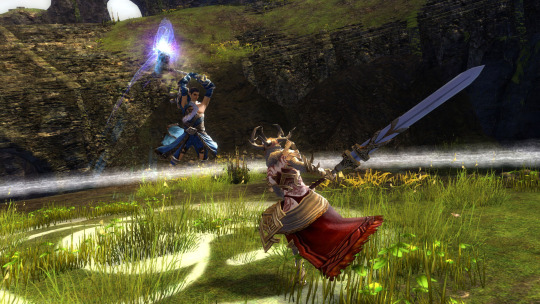
Mist degradation
The drawback of possibly beating death itself is that something can go terribly wrong in the process, and there's also no telling what could happen when one is killed.
The working theory is that people are "remembered" by the Mists like everything in the battlegrounds, and when a magic surge happens, it attempts to restore certain things to their previous state, just like a Fractal would do. However, as that attempt is being made, part of one's soul and/or life essence seems to either degrade or get absorbed by the Mists themselves, and if there's not enough of it left, the MW never comes back.
This phenomenon has been called "Mist degradation", and what exactly happens to those who perish definitively due to it is a mystery. Some say that their spirits are forever lost to the Mists, trapped in a sort of separate afterlife or directly consumed, while a few believe that they'll be reincarnated into one of the Tyrias connected to theirs at the time of death. Whatever the exact process behind resurrection might be, the data clearly shows that the risks of not returning and lasting signs on the resurrected increase with the frequency of deaths, but that it also decreases as time passes between them, along with variables such as age and overall health. How much those amounts are, no one exactly knows and varies on the individual, but this phenomenon is enough to keep most MW from repeatedly charging into battle without a single care.
Mist degradation is ultimately a game of chance that makes becoming a veteran fairly uncommon, as many underestimate its effects or overestimate their own abilities to survive it, or simply perish for good after a death like any other despite precautions taken. While the longer someone has been in the War does seem to increase their chances of survival, there's no clear mark of its threshold and one can still overdo it easily, be it through overconfidence or necessity, and in a constant state of war through harsh terrain it's hard to avoid dying at least once per reset. It's worth noting that not all MW fade into the Mists due to degradation, as many just decide to leave the Mist War for good before that happens, either by caving under the weight of neverending loss and horrors of war, or when they feel like they've done their part.
While dying during a magic surge doesn't really have an impact, dying during a reset is something one wants to avoid as much as possible, since it generally does not bode well for the MW involved. Such an event marks a statistical peak of sudden permanent deaths, more lasting effects on those that do get resurrected, and especially MW finding themselves far from the nexus after the reset itself. Due to such a high risk and the fact that the latter may happen to those who were alive but far from allied territories, all MW of any Tyria make sure to stop fighting and hurry back to their lands as soon as the last warning signs begin, especially in order to avoid those who specifically set out to kill retreating soldiers during the de-facto truce.
New recruits in particular are at risk of fading before they even get a chance to experience resurrection all, usually after ignoring the words of their veterans and getting themselves killed before the Mists have had the time to get a firm hold on their presence within them. Recently-revived MW are also discouraged from throwing themselves right back into the fray, at least as long as push doesn't come to shove. Even though the time taken to travel back to the battlefront is usually enough for the risk of permanently dying to diminish, the possibility of ambushes or running into other deadly issues on the way still keeps many from leaving camp too soon. Due to it all, MW are encouraged to take breaks and return to Tyria when they feel like they're close to surpassing their safe limit. Not all are inclined to do so, however, thinking their attunement to the Mist could irreparably waver and result in their permanent death when they return, so they usually switch to a safer role in the main camp or harvesting resources. It actually seems to be enough, as there are individuals who have continuously been in the Mists for decades and are still kicking.
Due to the many unanswered doubts, Mist degradation as a concept is also full of superstitions and subsequent scholarly debates over the validity of the huge variety of claims made by MW through the centuries. One of the more statistically possible claims is that the chance of Mist degradation happening becomes higher the deeper the fallen are into enemy-controlled zones when they are reassorbed by the Mists, but some take it to the extreme and believe that bringing the bodies of allies back to controlled areas or even closer to the main camp before they disappear will actually increase their chances of survival. As much as some try to do such a grim yet selfless service for their allies, it's a rarer luxury the further one is from their territory, and eventually many end up leaving it up to fate.
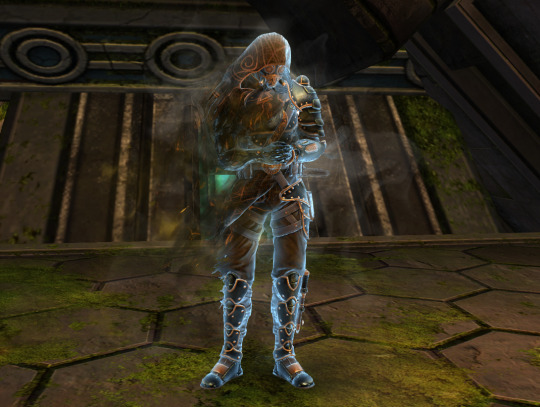
Mist anomalies and corruption
Some areas are also said to be cursed places to die into, and while the curse itself is considered just a superstition, there have been confirmations of weird magical fluctuations in those areas, which may result in Mist anomalies.
Some theorize that such anomalies are rifts in the fabric of the Mists caused by degradation or other unknown phenomena, but their effects have rarely been documented so far. Any equipment left to record said events gets moved during the reset, and volunteers willing to be there in person are scarcely found, so no hypothesis has ever been reached, let alone a definitive conclusion. The most common way to refer to it is that "the Mists swallowed someone", following the words of some who witnessed such events from afar. While these anomalies are rare and even more rarely stick around for long, they sometimes leave some small places of power behind, not as strong as nexuses but useful nonetheless. While they're generally safe to interact with and study, superstitions tied to dying in the exact vicinity of those places are widespread across all Tyrias, and it generally leads to temporary truces between enemies around their area of influence.
In some rare cases, MW might barely survive Mist degradation, being resurrected but appearing "changed" in ways that are not "right". While usually the effects are temporary (phantom pains, illness and weakness) or only affect the mind (amnesia, erratic behavior, etc), sometimes the MW can present notable physical differences or be so weak that they may quickly die for the last time. Such differences often appear as rashes or wounds, ones that often weren't supposed to be there and can't be easily healed, which eventually end up becoming "Mist-corrupted", as the affected body part degrades and twists in disturbing ways, all as it starts emitting misty particles and at times expands to the rest of the body. Sadly, a non-trivial amount of those so severely affected by Mist degradation end up becoming dangerously hostile and have to be put down, or eventually wander off on their own, but a few do remain stable and continue to act normally, at times barely noticing their affliction.Mist-corruption also incidentally happens to MW who still make it back after a long time of being supposedly dead, or that come in contact with Mist anomalies. It's still unknown whether there's a link between the two phenomena or it's all just a coincidence. One notable example is Dugan, who mentions that he managed to get his armor infused with the mist coming from the places of powers of the battlegrounds, and that another fellow who tried to touch the same energy orb ended up turning into a rabbit that allegedly still roams around camp. Curiously, very few veterans say they remember both of them, but they all also mention that many years passed between their disappearance following the event the human described and his sudden return with quite an array of treasures for sale. Perhaps there's more that Dugan isn't remembering or simply avoids saying, along with dodging all questions about his partially mist-corrupted body and not taking off his mask or clothes around others, but no one seems to really mind his presence.

15 notes
·
View notes
Text
Anet made Valentine day cards again!!
Instagram vers



Bsky / Twitter vrs



seems the bsky and twitter versions of Isgarren's got typos lmao
136 notes
·
View notes
Text
I'm doing the level 80 personal story quest, to destroy the Ossuary where Zhaitan creates it's hordes. Walking around these temple grounds with Trahearne, observing all these rituals the old Orrians would go through when a loved one died... and it's just the stages of grief. Denial is missing, cause presumably they wouldn't be bringing the deceased to this temple if they were still in that stage. We got anger

Bargaining

Depression

Acceptance

I'm really appreciating all the details in this game.
134 notes
·
View notes
Text
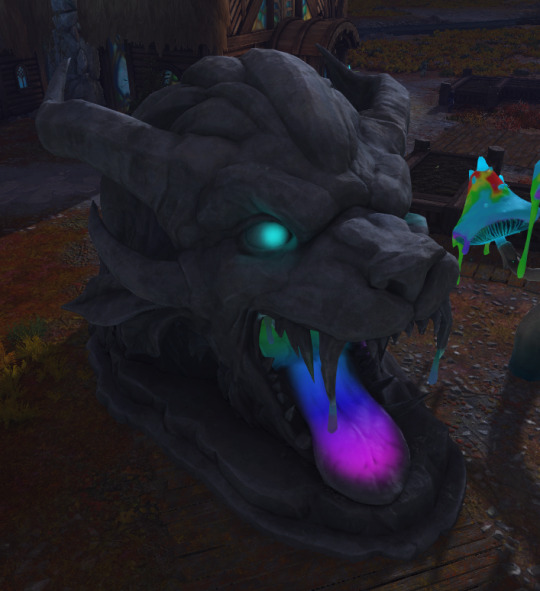

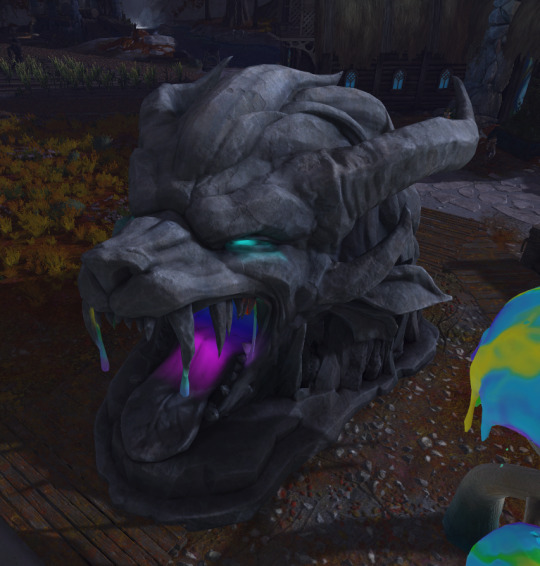
Getting a giant head entryway of a Charr who's high af is certainly something. I like it.
Part of the Twisted Imaginarium set from the Gemstore.
21 notes
·
View notes
Text
RYTLOCK BRIMSTONE APPRECIATION POST!!





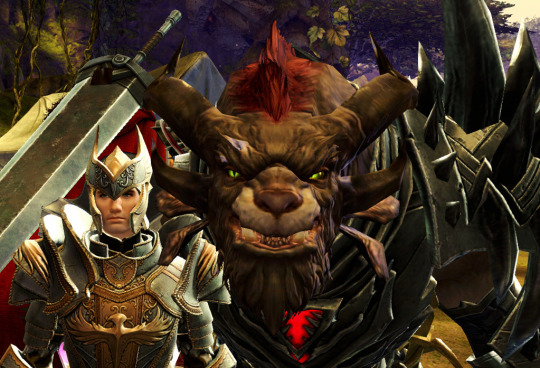
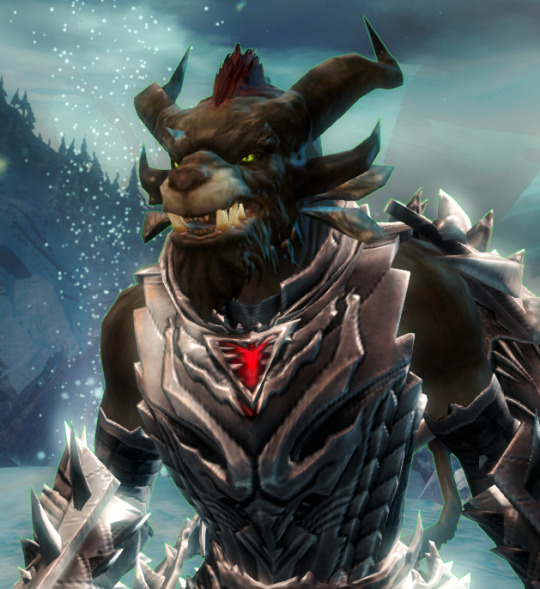





I LOVE MY TRAUMATIZED OLD MAAAAAN ROOOAAAAARRR he just wants to do good it makes me so emotional please be nice to him i want nothing but the best for him
(thank you @brightwingedbat for the screenshots! the art in the second one is by me, the others are GW2 promotional materials i got from google / the wiki)
54 notes
·
View notes
Text
this is all only a journey
August stood with his knife at the ready, his former mentor watching from across the field. The older charr scrutinized him carefully before raising his sword and shield–but still he didn’t move. It was almost painfully nostalgic; at a glance, Zerek hadn’t changed much, from his simple garb to his plated helm. Beneath it, the sandy-furred charr’s black mask had grayed, but given his experience with his own sire, August doubted the passage of time had dulled the old cat’s senses or reflexes much, if at all.
“What are we waiting for, old man? I know you aren’t afraid I’ve improved that much.” The click of Zerek’s tongue was audible from twenty paces away, and August didn’t fight the grin that brought to his muzzle. “The match will continue until one of us is at the other’s mercy. Use the spells you’ve honed since we last met, but don’t involve bystanders. Weak-minded souls won’t always be at your disposal.”
August charged the moment Zerek finished stating the terms. He swung his blade upwards as he ran, releasing energy along the ground to sweep towards his mentor–as it exploded forward, bright luminescent magic mixed with dirt and stone, he shrouded himself and ducked away. Zerek charged through the wave of earth and magic as it hit him, and three copies of the old charr materialized in formation around him on the other side of the resulting cloud of debris, on watch for August’s attack. He could hear the other charr’s thoughts like his old mentor was shouting them aloud, Come out, Augustus. Where will you strike from?
A clone of August took form and shot forward towards Zerek, and as it ran forward, three phantasms split from it. Zerek responded without hesitation. Two of his phantasms intercepted August’s clone, running it through the neck and chest with their swords, and the third threw his shield, charged with magic, in a powerful arc that punched through the psychic projections August’s clone had generated. As the phantasms shattered into glimmering purple shards that danced and glistened in the air, the shield slowed before returning to its owner’s paw. “You know that’s not enough to distract me, Augustus!” The Zereks called out together. “I’d have thought you’d be better at facing your enemies by now, after so long with your sire?”
“Of course,” August said, stepping out of his shroud, knife in paw, behind the group of Zereks. “Let’s dance, old man.” August slashed with his knife, freeing one phantasm of its sword arm, and stepped into the group of Zereks. A Zerek jumped away while two others swung at him–their attacks were brutally cut short as streaks of amethystine light shot through their chests, shattering their magic as August mentally tugged at the remains of his projections which Zerek had just destroyed.
The magic of Zerek’s apparitions destabilized and August blinked forward as they exploded, lunging his knife forward at the older charr’s torso. The gleaming pink blade was parried away by the other charr’s sword, and there their dance began in earnest. He slashed and stabbed while Zerek blocked and evaded–anytime the older charr would attempt a strike of his own, August would simply allow the blade to glide through him as the amethyst needles that floated in an array behind him winked in and out of existence. August had learned a lot in the twelve years he’d been working alongside his sire, but the most important thing his old man had imparted upon him, perhaps, was patience–this, he hoped, was enough to handle Zerek’s precognizance. Whenever Zerek’s form blurred and a clone would appear, he would launch a needle out to destroy it, all while continuing to press his advantage against his former mentor. This, however, was only a means to an end: Zerek’s first lesson to him, after all, was that a mesmer’s greatest strength was the array of weapons at his disposal.
The telltale ticking of Zerek’s chronomancy began slow and echoing in August’s ears as the older shaman’s eyes glowed bright behind the visor of his helmet. The younger charr had tried to replicate it himself many times in the previous months–he knew its distinctive sound as well as he’d memorized the older charr’s lessons, but as of yet, he’d been unable to reproduce the specific unraveling of chaos that Zerek could unleash. “Your old man really has been a good influence, hm?” Zerek grunted as he weaved away from a swipe of August’s knife. “I have to admit, I didn’t approve at first.” “Suppose so. It was bound to happen eventually,” August answered as he shot his needles away from him in a fan, one behind them and one to his left and right. The old man’s shield shattered the only one that went for him, and August ceased his barrage of spellcasting and blade swinging.
Zerek’s magic reached its zenith, and August could see the smirk stretch across the older charr’s muzzle–his old mentor knew he’d won. His stomach shifted as the spell activated and his eyes flared: Gaius had never fully explained how his spell-jacking worked, but he’d seen it in play numerous times during the early days–as with most things, that was generally enough for him to pick up on how something worked enough for him to replicate it. Unlike his sire, he had to stop his own casting whenever he stole someone else’s spell, but if the situation was right, it wouldn’t matter that he was defenseless for a moment. Here and now, time slowed to a halt around he and Zerek: airborne debris, sweat, and even both charr’s breathing decelerated to an almost imperceptible crawl. Exactly two seconds relative stretched into ninety seconds experienced–and then August jerkily finished his breath as his spell took hold of the well of magic beneath them, releasing him from its grip on space-time. He doubled over, paws on his knees from the exertion, and two more seconds passed before August teleported back to where one of his needles waited where their magic had clashed earlier, and then he transmuted his two remaining needles into clones. He peered through their eyes and saw from three angles the bright dome of pink light. Each version of him raised his paw, and as the well finally began to pop from bottom to top like a bright bubble, they let loose a torrent of needles into it.
The psionic blades sang as they flew along the wind, shredding the air itself as they shattered the bubble and pincushioned the charr inside. Five seconds passed before he dropped his paw–his clones dissipated with the last of the blades, and August called, “If you’re gonna counter, I think now’s a good time for it!” Dust obscured his vision, and August realized he had indeed gone a bit overboard when the shifting of sand alerted him to Zerek’s movement. The older charr stepped out of the dust cloud entirely nude, armor shredded except for his helmet, and growled, “No, I think you’ve made your point.” August whistled appreciatively. The older charr sighed as he pulled off his helmet and situated it to protect his modesty. “What is it that you want from me after so long, Augustus?” August sighed, but kept his smile as he looked at Zerek. “I need your help, I think.”
21 notes
·
View notes
Text
I really do wish anet would lean more into the fact that humans are literal aliens to Tyria. They're an invasive species. I think it'd be fascinating if there were foods they couldn't eat. If they didn't have certain animals because they didn't survive the journey to this new world. If certain biomes were even more hostile to them than other races just on account of This Is Not Your World.
It's SUCH a cool concept for humans in any setting I want to see it leaned into!!
77 notes
·
View notes
Text

I'm bored so have Aereth Combat Chatter
no but for real these just came to me in the shower so I am tossing em on here.
Air Attunement Spear Elimination:
"Calm waters hide my Raging Storm!"
"No contest for my mastery"
"He would be proud to see me putting this to good use..."
"That one was for you" (He is referring to his old deceased warbandmate)
Water Attunement Spear Elimination:
"Sometimes you must harm to heal"
"Maybe next time you'll respect the currents"
"Taken by the undertow!"
Fire Attunement Spear/Spell Elimination:
"My rage embodied"
"For those taken from us!"
Earth Attunement Spear/Spell Elimination:
"Not my usual style"
"I have to stress that this is really embarrassing for you"
Healing an ally:
"Always someone for me to patch up, huh?"
"By all means, I had nothing else to do"
"You keep getting hurt, I keep patching you up."
"Stop whining, I have you"
"You're barely hurt, come on"
Healing an Ally (Critical):
"You'll be okay as long as I am here"
"I have you! No giving up"
"Come on cub, you can keep going"
"Stay on your paws!"
Watching an ally die:
"Patch them up, only for them to die anyway... I'm tired"
"Another one gone... sigh"
"I can't fix that"
Is healed:
"Always nice to have a colleague"
"Could not have done it better myself"
"Oh, I am not used to being on the receiving end of this"
8 notes
·
View notes
